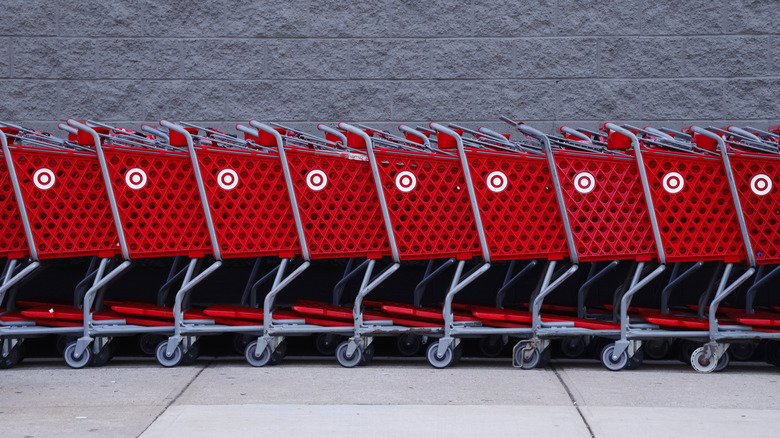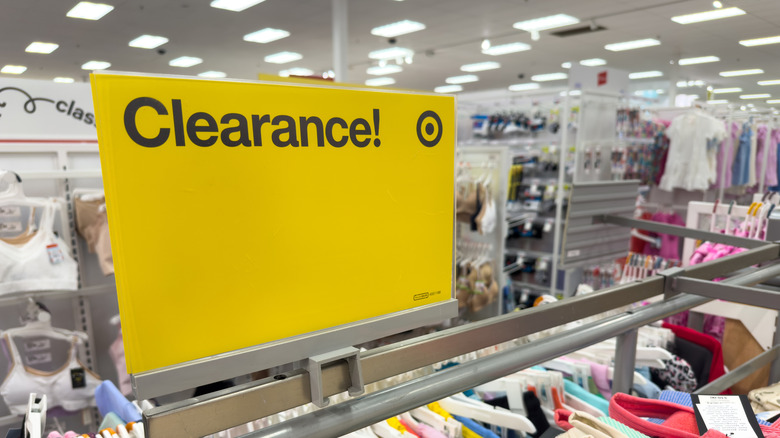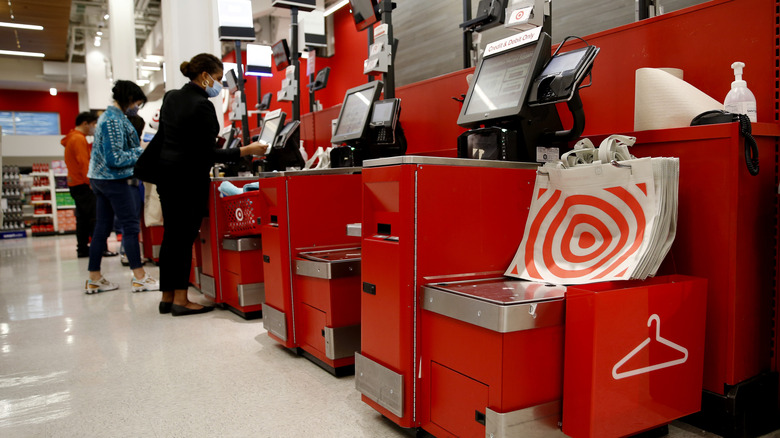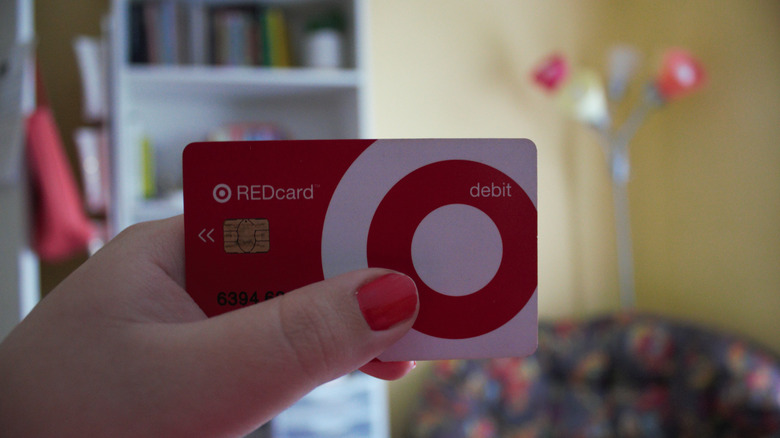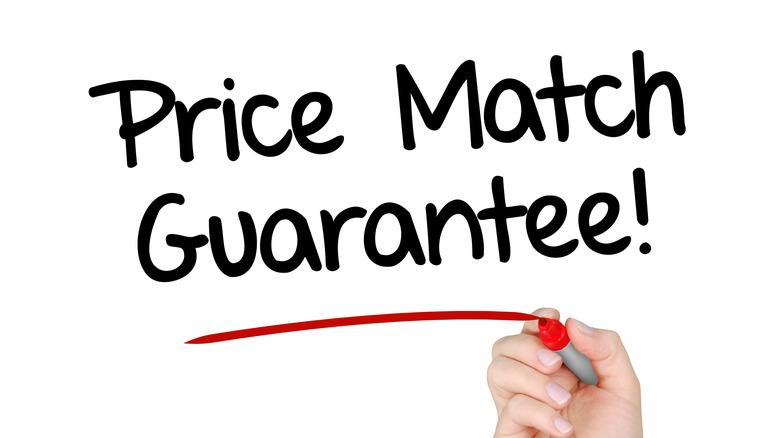Massive Mistakes That Are Costing You Extra Money At Target
The value Target brings to shoppers across America is significant. From its now-constant military discount to all manner of sale offers, Target provides great access to the things people need on a daily basis while also frequently delivering solid prices. The stores can be found in abundance, as well, with almost 2,000 of them spread across the United States — with the largest measuring in at more than 200,000 square feet of total real estate. In fact, the red target logo is so prominent today that most Americans live within a 10 mile radius of at least one Target store.
Considering the ubiquitous nature of Target in the modern shopping landscape, it's perhaps surprising that numerous mistakes can still come into play for shoppers frequenting both its brick-and-mortar locations and digital shelves. As is the case with all shopping interactions, there are some behaviors that should become a standard part of any consumer's approach to purchasing goods. Target is no different, and the red retailer often makes it easy to tack on additional savings, and key perks, if you know how to activate them. Failing to take advantage of these important benefits and strategies will cost you extra each time you shop at Target.
Skipping the clearance section and not paying attention to weekly sale offers
Target is known for its sales and clearance offerings. Many retailers deliver these kinds of discount opportunities to their shoppers. Whether it's clothing that's going out of season or groceries nearing their expiration date, all kinds of goods can be found at discounted prices. Target is no different: When there's a need to make room for new merchandise that's coming, the gigantic retailer will mark down its prices on just about any kind of good you might find within its walls.
The clearance section features a particularly important discount opportunity. In many instances, clearance pricing is even lower than sales, giving buyers a great opportunity to get things at rock bottom costs before they are no longer available. Carefully perusing the clearance racks can be a fantastic way to find extreme value on all kinds of fantastic gear that you might be on the lookout for. There's no telling what you might be able to save money on, so exploring Target's discount offers is a must.
Paying for bags every time you shop
The modern shopping landscape has changed in many ways. In years past, shoppers would typically pull up to the register with their basket full of goods and start loading their items into plastic bags to facilitate a journey back home. However, single-use bags now cost money in many stores across the country. Target is one of the retailers that now charges consumers for bags, but that doesn't mean you have to subject yourself to this price increase. Especially when bringing your own bags from home is incredibly simple. Buying a few reusable bags when you head to Target or any other store, and then leaving them in the trunk of your car, is all it takes to avoid having to pay for bags each time you shop.
Target charges 10 cents per bag when loading up your purchases in single-use carriers. While that might not sound like a big expense, if you're purchasing a sizeable amount — bringing home groceries, clothing, and even personal electronics — you might end up throwing away a few extra dollars on bags that you'll likely shove into a cupboard and forget about. If you buy bags with each new visit to a Target store, the wasted cash you could have saved by just investing in reusable bags can easily add up to a surprising amount.
Not signing up for a RedCard or joining Circle
Target features important loyalty programs that shoppers who frequent the retailer should engage with if they want to enjoy the best bargains possible. First up is Target Circle. Signing up for this membership program is free (with additional paid membership tiers) and after you enroll you'll receive a steady stream of personalized offers that can help reduce the cost of things you might buy from Target on a regular basis. Becoming a Circle remember also provides a 1% bonus reward every time you spend in a Target store. Unlike a credit card cashback program, in which all manner of downsides can come into the picture to reduce the value of your rewards points, Target's program features a straight bonus system that you can use as a redemption option to pay for purchases in the future.
Another important offering from Target is the RedCard. However, to sign up for this consumer tool you'll need to go through a credit check, even if you aren't enrolling in the credit card program but rather Target's reloadable cash card, or its debit offering. The RedCard has recently been rebranded and is now known as the Circle Card, rolling the brand's loyalty programs into the same framework. Signing up entitles you to a 5% discount on all purchases you make in store and free shipping when shopping online (although some exclusions like lottery tickets and prescriptions apply). Plus, there are other discount opportunities at Disney World for members.
Not checking price matches
Target is one of many retailers that engages in price matching. If you find the same item sold at Target on a competitor's website, in a printed ad, or distributed via a digital medium, you can bring the advertised price with you and get a rate reduction right at the register. It's important to keep in mind that some prices won't qualify for Target's price matching policy. Products sold by third-party vendors or marketplace sellers aren't always new items, meaning Target won't match their listed prices. Clearance and liquidation pricing, and even typos in an advertisement, also won't be honored at the register in a Target.
Even with these additional stipulations in mind, getting a better deal on your purchases at Target is fairly simple. Price matching has become such a prominent feature of shopping at most large scale retailers that failing to check on opportunities for a rate reduction is an easily avoidable mistake. Fortunately, Target also provides a 14 day window in which you can bring your receipt back to the store to get the difference refunded to you. The same rules apply when it comes to eligibility so it's always worth checking, even after the fact, to see if you can save a few dollars.
Failing to make a shopping list before arriving
Failure to create a shopping list can be a fatal mistake. No matter what store you're heading into, any time you're shopping for more than a singular item you should aim to create a shopping list for guiding you through the retail experience. This practice is most prominent when performing routine grocery shopping, but can be equally valuable when buying just about any other products you might typically purchase.
Retail stores like Target engage in all manner of upselling practices and trickery designed to get you to part with more of your money than you intended. Target's store layouts do a good bit of the heavy lifting on this front, as do pricing structures, and even the lighting used inside Target stores. While these are all designed to entice you to spend more money, there's an easy way you can short circuit these efforts. Planning your visit with an included shopping list van go a long way to defeating these practices. By writing down you can avoid the splurge purchasing that frequently comes into the picture while shopping at giant retailers like Target. There's no getting around the fact that your shopping list can act as a potent defense when navigating an store's aisles. It's fine to pick up a few extra things here and there, but a shopping list will help you rein in or even avoid splurges altogether — especially if you've already recently fallen victim at another store.
